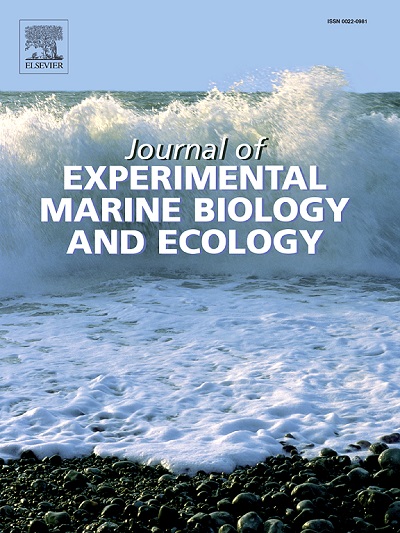基于 DNA 的帽贝 Patella depressa Pennant 1777 贝壳内石群落演替研究
IF 1.8
3区 生物学
Q3 ECOLOGY
Journal of Experimental Marine Biology and Ecology
Pub Date : 2025-04-10
DOI:10.1016/j.jembe.2025.152103
引用次数: 0
摘要
生物和非生物碳酸钙结构被世界各地的生物侵蚀生物(或称 "内含石")用作基质。随着全球海洋酸化和变暖的加剧,海洋沉积物的侵蚀效率可能会提高。在这里,我们利用扁虱 Patella depressa 的生长曲线数据和 16S rRNA 测序,探讨了 P. depressa 在大不列颠各地贝壳上内石群落的演替情况。在研究地点内,叶片虫的年龄与侵蚀程度密切相关,但在不同研究地点之间存在差异,当校正年龄时,位于寄主范围中心的研究地点的侵蚀程度更大。蓝藻的α-多样性和丰富度随侵蚀程度而降低,尤其是在侵蚀的早期阶段。在贝壳年龄为 1.4 至 2.7 年时,扩增子序列变异体(ASV)的累积率约为 80%。来自不同地点的贝壳中的蓝藻群落组成各不相同,但尽管存在这些差异,特定分类群的丰度并没有明显的模式与帽贝的年龄或侵蚀程度相关联。研究结果表明,从分类学的高分辨率来看,蓝藻群落演替比以前认为的更为复杂,而且可能因地点而异。不过,观察到的趋势表明,蓝藻群落演替发生在体内钙化生物上,郁金香藻在 1.4-2.7 年后向高潮群落转变。本文章由计算机程序翻译,如有差异,请以英文原文为准。
A DNA-based investigation of endolithic community succession on shells of the limpet Patella depressa Pennant 1777
Biotic and abiotic calcium carbonate structures are used as a substrate by bioeroding organisms, or euendoliths, worldwide. Euendoliths can have serious ecological effects on living hosts, and with global increases in ocean acidification and warming, the efficiency of erosion by marine euendoliths is likely to increase. Here, we used growth curve data for the limpet Patella depressa and 16S rRNA sequencing to explore succession in the endolithic community on the shells of P. depressa throughout its range across Great Britain. Limpet age correlated well with the extent of erosion within sites, but differed among sites, with those at the centre of the host range showing greater erosion when corrected for age. Alpha-diversity and richness of cyanobacteria decreased with the extent of erosion, particularly during the earlier stages of erosion. A decrease in the accumulation rate of Amplicon Sequence Variants (ASVs) occurred at around 80 % of cumulative ASVs, at a shell age of between 1.4 and 2.7 years. Cyanobacterial community composition differed among the shells from the different sites, but despite these differences, there were no discernable patterns in the abundance of specific taxa that were associated with limpet age or the extent of erosion. The results revealed that, when examined at a high taxonomic resolution, cyanobacterial community succession is more complex than previously thought, and may be site-specific. However, the trends observed indicate that cyanobacterial community succession occurs on calcifying organisms in vivo, with a shift towards a climax community after 1.4–2.7 years for P. depressa.
求助全文
通过发布文献求助,成功后即可免费获取论文全文。
去求助
来源期刊
CiteScore
4.30
自引率
0.00%
发文量
98
审稿时长
14 weeks
期刊介绍:
The Journal of Experimental Marine Biology and Ecology provides a forum for experimental ecological research on marine organisms in relation to their environment. Topic areas include studies that focus on biochemistry, physiology, behavior, genetics, and ecological theory. The main emphasis of the Journal lies in hypothesis driven experimental work, both from the laboratory and the field. Natural experiments or descriptive studies that elucidate fundamental ecological processes are welcome. Submissions should have a broad ecological framework beyond the specific study organism or geographic region.
Short communications that highlight emerging issues and exciting discoveries within five printed pages will receive a rapid turnaround. Papers describing important new analytical, computational, experimental and theoretical techniques and methods are encouraged and will be highlighted as Methodological Advances. We welcome proposals for Review Papers synthesizing a specific field within marine ecology. Finally, the journal aims to publish Special Issues at regular intervals synthesizing a particular field of marine science. All printed papers undergo a peer review process before being accepted and will receive a first decision within three months.

 求助内容:
求助内容: 应助结果提醒方式:
应助结果提醒方式:


